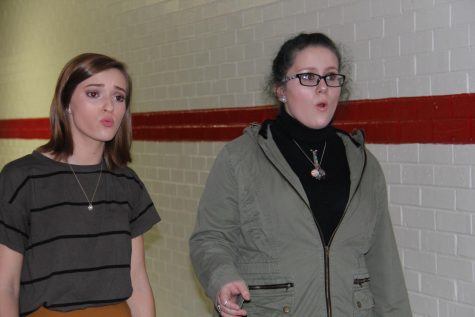Students witness historic eclipse
Wearing their eclipse shirts, a group of students looks up mesmerized by the eclipse.
On Aug. 21, the country experienced its first solar eclipse since 1979, and OHS was situated in a phenomenal place to watch it.
A solar eclipse occurs when the earth, moon, and sun are aligned. If one stands in the moon’s shadow, he or she is in the “path of totality,” which is where a total eclipse can be seen. St. Louis was fortunate enough to be within this path and this is why the students and staff of OHS were in such a great position to view the eclipse.
“It was honestly really cool,” said Garrett Summerfield (11) after the eclipse occurred. “You can see the outside of it (the sun) but then you can also see the sun’s atmosphere. It was all wavy.”
During each class leading up to the eclipse, videos were shown informing the students about what was going to happen, preparing them for a sight they would never forget. Science teacher, Mrs. Cynthia Jenkins gushed about her excitement for the upcoming event and reminisced about the previous eclipse in 1979. She was a senior in high school at the time.
At about 12:45 pm, the students of OHS were finally released to the football field to watch this once-in-a-lifetime experience. The field was buzzing with excitement as Assistant Principal, Mr. Ross Bullington counted down the minutes and then the seconds until the sun would be completely blocked by the moon.
“Five… Four… Three… Two… One…” Mr. Bullington said over the football field speakers. “Ladies and Gentlemen, we have reached totality!”
At this moment, the students and teachers removed their eclipse glasses and stared in awe at the sight around them. The field was surrounded by a beautiful 360 degree sunset.
“No picture does that justice,” said social studies teacher Mr. Roger Wilke.
In the sky above, the moon was covering the sun; only the sun’s glowing corona could be seen. The stars and several of the planets became visible. The crickets began to sing and the birds quieted.
“I was mesmerized by the beauty around us and how dark it got and the temperature (change),” Alisa Lazareva (11) said.
The next North American solar eclipse will be on April 8, 2024.

Hello! I’m Nicole and I’m the editor-in-chief this year, along with Mckenzie. I was on the yearbook staff my sophomore year and I was the copy editor...























